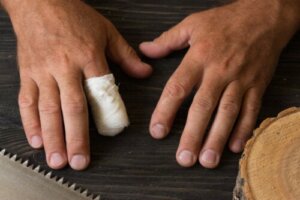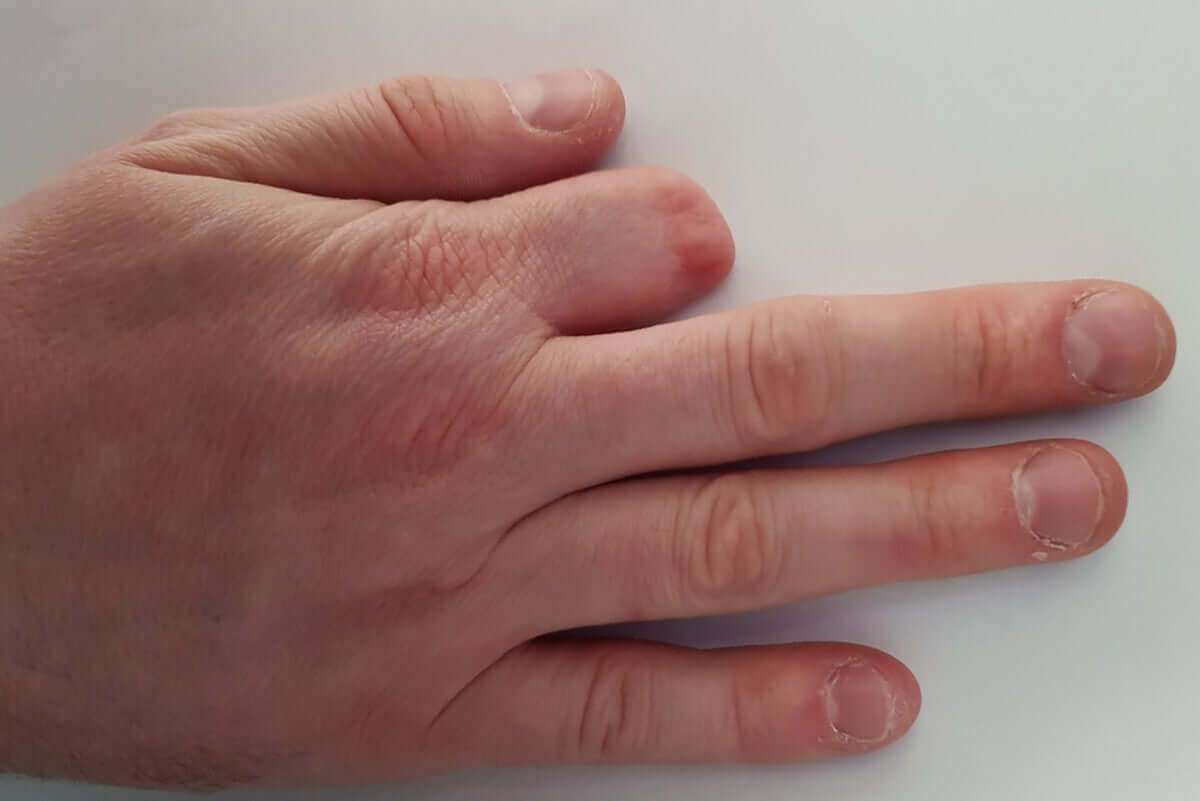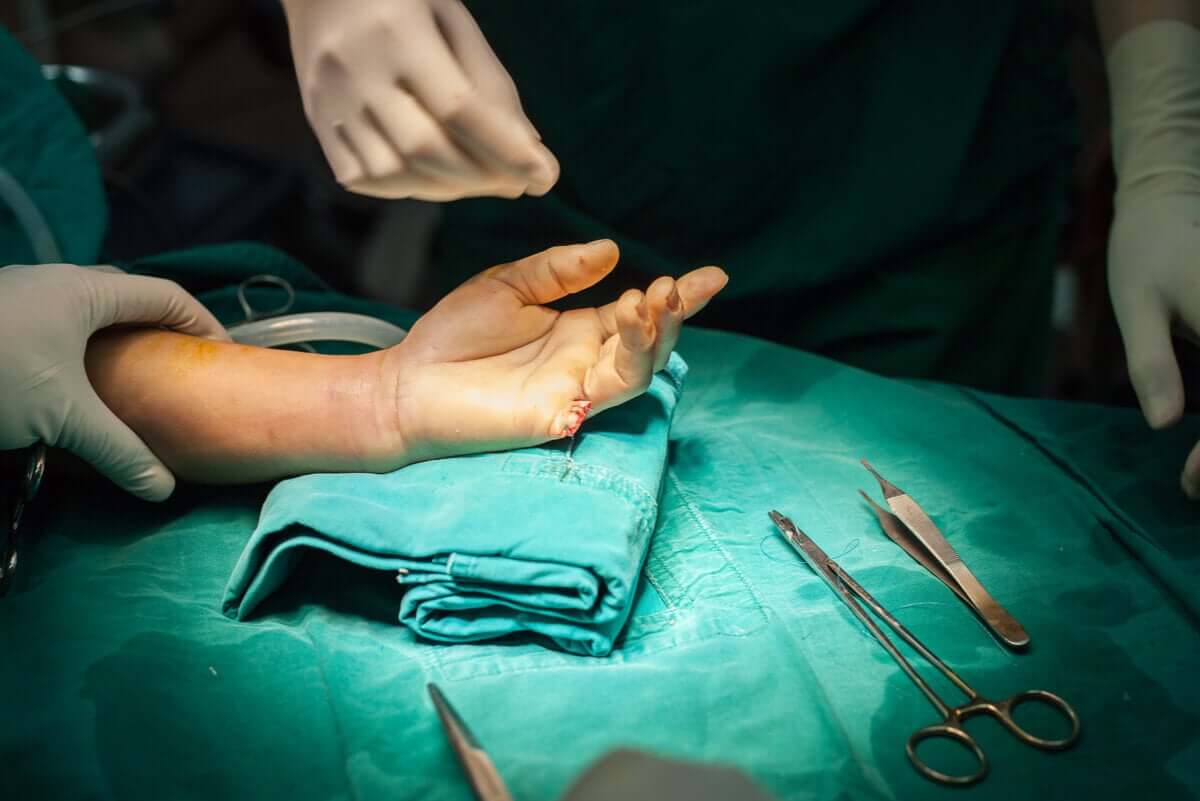First Aid in Case of Accidental Finger Amputation


Written and verified by the doctor Leonardo Biolatto
The accidental amputation of a finger is a frequent situation in the emergency department. Most cases occur with fingers, but they may also occur with toes. Overall, there are many causes that can lead to this problem.
For example, traffic accidents or industrial accidents in factories or farms are common. There may also be accidental amputation of a finger following electrocution, burns, or freezing processes. There are even cultures in which this is done as a punishment for criminals or as a ritual.
Few people know how to properly proceed when faced with the accidental amputation of a finger. Therefore, in this article, we’ll explain the most basic first aid measures. This way, you can minimize the risk of losing the limb.
First aid for accidental finger amputation
According to a study carried out at the Hospital de San José in Colombia, accidental finger amputation is one of the most important causes of emergency care. In fact, it’s one of the most frequent emergencies in hand surgery.
This is an injury that the patient must treat quickly. The earlier and more efficient the care, the more likely it is that the amputated part can be reattached. Therefore, the first step is to call 911.
When calling, it’s essential to explain the accident and the characteristics of the injury. A clean cut is not the same as a crushed limb. In addition, the medical service will inform you what first aid steps you must take.
1. Stop the bleeding
Once emergency services have been contacted, the first step (which can also be done simultaneously with the call) is to stop the bleeding. After accidental finger amputation, there’s usually significant bleeding.
Try to stop it by putting pressure on the wound. At the same time, the injured arm should be raised above the level of the heart. This makes it more difficult for the blood to flow in that direction.
However, specialists don’t recommend squeezing or bandaging the area too tightly. Applying too much pressure to any part of the limb can cause blood flow to be interrupted. This is detrimental to the finger, as it would become ischemic and no longer viable for reconstruction.

2. Calm the patient down
An article by Dr. Leopoldo Cagigal explains that calming the injured person is another basic step. An accidental amputation of a finger causes a lot of pain and can even lead to shock.
That is why doctors recommend laying the person down. Ideally, you should elevate their feet to avoid dizziness. Similarly, specialists advise keeping the person warm with a blanket or clothing. You should try to talk to them, calm them down, and reassure them.
There’s a tendency to think that administering alcoholic beverages or food is beneficial. However, the opposite is true. In fact, doctors suggest not eating or drinking anything in case they must perform any surgical procedure in the following hours.
3. Care of the amputated finger
There are many myths about what to do in the event of an accidental amputation of the finger. In movies and series, this scene is very common, but many of the actions that appear aren’t the correct procedures.
An article from the American Academy Orthopaedic Surgeons briefly explains what you should do. The first thing to do is to clean the wound, preferably with sterile gauze. You shouldn’t remove rings nor the patient’s clothing. Doctors also advise against rubbing the area.
Regarding the amputated finger, once it’s been cleaned, it should be covered with wet gauze. In addition, any part must be preserved, no matter how small it may be. Once this is done, place it in a clean waterproof bag and close it hermetically.
If there are several amputated fingers, they should be placed in separate bags. You should place these bags in other bags containing ice. Ideally, you should keep the finger at a temperature of about 4 degrees Celsius (39.2 degrees Fahrenheit).
Hospital care for accidental finger amputation
As we’ve seen, calling the emergency department is a priority in the event of accidental finger amputation.
Once at the hospital, the main objective is to stabilize the patient. The doctor will then examine the stump and the finger. They’ll then be able to determine whether the finger can be reattached.
In any case, doctors administer anesthesia to proceed to heal the wound. The wound must be thoroughly debrided to remove any remaining damaged tissue.
The final route is usually surgery, either to reconstruct the finger or to close the wound. A study published in the Journal of the Andalusian Society of Traumatology and Orthopedics states that the use of semi-permeable dressings helps regeneration to occur in a short time.
You may be interested in: Types of Gangrene: What It Is and What Causes It
When isn’t it advisable to reattach the amputated finger?
There are many reasons why doctors may not recommend reattaching the amputated finger. One of them is if the injury is very complex and the hand isn’t in good condition. For example, if it’s crushed. Another reason is that the parts haven’t been well preserved.
In addition, the doctors must take into account the patient’s health. There are certain aspects, such as age, smoking habits, or diabetes, which have a negative influence on finger reimplantation.

Reattachment after accidental finger amputation
After the accidental amputation of a finger, there are a series of aspects to consider to assess whether or not the finger can be reattached. According to the Navarra Health Service, the finger should not have been in ischemia for more than 6 hours.
Specialists recommend trying to reattach the thumb whenever possible. Especially in children. On the other hand, reattachment is more likely if it has been a clean cut.
Recovery after accidental finger amputation
After accidental finger amputation, the recovery process may be lengthy. Most people require rehabilitation to maintain hand mobility. It all depends on what the injury was like.
However, it’s usually necessary to exercise it regularly. For example, gradually extend the finger. To do this, doctors recommend placing the hand on a table and lift each finger gently. The patient must also bend it progressively.
You may also want to read: Numb Hands: Why Does it Happen?
It’s important to act quickly
In the event of accidental amputation of a finger, it’s essential to act quickly. What we must keep in mind is to stop the bleeding without cutting off the blood flow.
We must also try to preserve all the parts that have been amputated. You can use clean bags and apply cold for this.
However, the most important thing is always to call for help and get to the hospital as soon as possible.
All cited sources were thoroughly reviewed by our team to ensure their quality, reliability, currency, and validity. The bibliography of this article was considered reliable and of academic or scientific accuracy.
- Eslava Echavarren, E., Goya Arrese, A., & García, S. (n.d.). Traumatología y Neurocirugía AMPUTACIÓN TRAUMÁTICA DE EXTREMIDADES • Definición. Retrieved from www.umm.edu
- Tratamiento de las amputaciones distales de dedos con apósitos semipermeables | Revista de la Sociedad Andaluza de Traumatología y Ortopedia. (n.d.). Retrieved February 4, 2021, from https://www.elsevier.es/es-revista-revista-sociedad-andaluza-traumatologia-ortopedia-130-articulo-tratamiento-amputaciones-distales-dedos-con-13115064
- Lesiones y amputaciones de las yemas de los dedos – OrthoInfo – AAOS. (n.d.). Retrieved February 4, 2021, from https://orthoinfo.aaos.org/en/diseases–conditions/fingertip-injuries-and-amputations/
- Torres-Fuentes, C. E., Julianandrés Hernández-Beltrán, •, Diego, •, & Castañeda-Hernández, A. (2013). INVESTIGACIÓN ORIGINAL Initial management of fingertip injuries: a treatment guide based on experience in the San Jose hospital (involving 91 cases). https://doi.org/10.15446/revfacmed.v62n3.39603
This text is provided for informational purposes only and does not replace consultation with a professional. If in doubt, consult your specialist.








